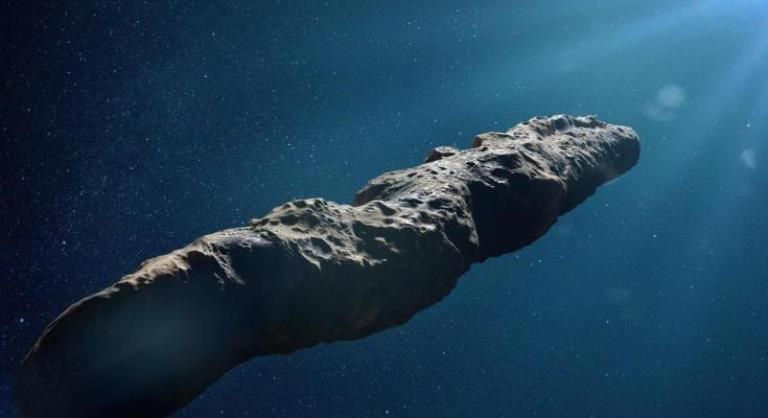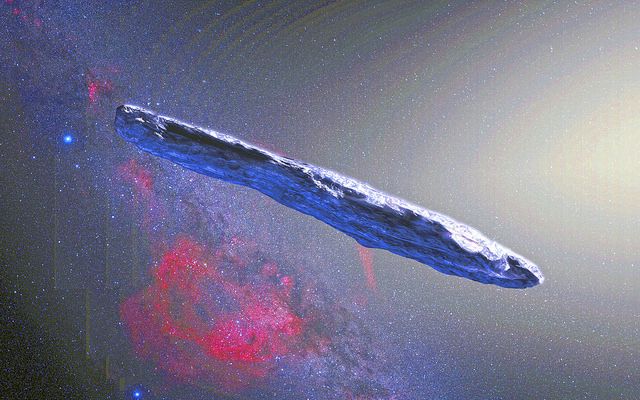How the Oumuamua Mystery Shook up the Search for Space Aliens
by Corey S. Powell December 25, 2018 (nbcnews.com)
• In 2017, an enigmatic object from beyond our solar system, named Oumuamua (depicted above), startled astronomers when it came streaking past the sun. In November 2018, Avi Loeb, the head of the astronomy department at Harvard University, co-wrote a paper with a post-doctoral student, Shmuel Bialy, reporting that Oumuamua is so unusual that scientists should consider the possibility that it could be an interstellar craft built by extraterrestrials. Oumuamua is a Hawaiian word meaning “messenger from the past.”
• Some of Loeb’s colleagues were intrigued. Others were disconcerted. But suddenly mainstream scientists were seriously talking about alien spaceships. Loeb is well aware that most scientists recoil from anything that sounds like UFO craziness. But he believes an overabundance of skepticism has cut them off from out-of-the box ideas. Says Loeb, “Why have a prejudice? Why argue that it must be natural? What do we gain, other than putting blinders on our eyes?”
• Penn State astronomer Jason Wright shares Loeb’s desire for open discussion. “There’s a real culture change. SETI (the search for extraterrestrial intelligence)is becoming a serious scientific discipline,” he says. Wright raises the possibility that a now-defunct alien civilization may have left behind artifacts on the moon where they could have survived, even if deposited there billions of years ago. Almost all such searches are destined for failure, Wright says, and all it takes is one success to change the world.
• Oumuamua’s unusual trajectory meant it had to have come from outside the solar system — and that it could have been traveling for millions of years. “It’s very elongated, with an axis ratio of at least 7 to 1,” astronomer Karen Meech of the University of Hawaii said. It’s at least seven times as long as it is wide — shaped like a cigar. Or, as Loeb proposes in his paper, maybe a flattened disk. At only 1,000 feet long it is too small to be a comet. And it has no distinctive comet tail. Also, it seems to be much more reflective than the typical comet.
• The biggest puzzle about Oumuamua was the way it moved. (see previous ExoNews article here) As it zoomed away from the sun, it sped up slightly, as if given an invisible push. Comets often accelerate that way when gases boil off their surface under heat from the sun. But observations by the Spitzer Space Telescope showed no such material coming off of Oumuamua.
• At this point, Loeb thought it was time to consider a more radical interpretation. Perhaps Oumuamua isn’t a comet at all, and that the acceleration was caused not by boiling gases but by the pressure of sunlight against a very wide, thin lightweight structure. Loeb and Bialy suggested that such an object could be technological debris or even “a fully operational (alien) probe.”
• Loeb anticipated a harsh reaction to his paper. One anonymous researcher disparaged the Bialy and Loeb paper as “irresponsible,” and “just out to grab attention.” Loeb shrugs off the reflexive dismissals, saying that his lofty academic position actually obligates him to be a pot-stirrer, “I can say these things other people can’t because I have tenure at Harvard. The whole idea of getting tenure is to allow you to be free in your mind. I used the opportunity of Oumuamua to make a statement.” “All I’m doing is following the standard scientific process, looking for explanations,” Loeb says.
Last year, an enigmatic object named Oumuamua startled astronomers when it came streaking past the sun, giving humanity its first close-up look at an object from beyond our solar system. This year, the interstellar visitor did something even more remarkable: It made it respectable to talk about alien spaceships.
The turning point came in November, when Avi Loeb, the head of the astronomy department at Harvard University, co-wrote a paper saying that Oumuamua is so unusual that scientists should consider the possibility that it’s not a far-out comet or asteroid, as his colleagues assumed, but rather an artificial structure.

In other words, maybe it’s an interstellar craft built by extraterrestrials.
Some of Loeb’s colleagues were intrigued. Others were disconcerted. But suddenly mainstream scientists were talking about how to tell if Oumuamua is a natural object or — as Loeb raised as a possibility in his paper — an alien spacecraft designed to capture the force of sunlight (a so-called lightsail).
Loeb is well aware that most scientists recoil from anything that sounds like UFO craziness, but he believes an overabundance of skepticism has cut them off from out-of-the box ideas. “The point of doing science is not to have a prejudice,” he says. “A prejudice is based on the experience of the past, but if you want to allow yourself to make discoveries, then the future will not be the same as the past.”

Jason Wright, a Penn State astronomer who recently launched a graduate program in SETI (the search for extraterrestrial intelligence), shares Loeb’s desire for open discussion — and offers an upbeat assessment of the field’s growing respectability. “There’s a real culture change. SETI is becoming a serious scientific discipline,” he says.
STRANGE VISITOR FROM THE STARS
It was clear from the start that Oumuamua (pronounced oh-MOO-uh-MOO-uh) would shake up astronomy’s status quo. Shortly after its discovery, scientists realized that the object’s unusual trajectory meant it had to have come from outside the solar system — and that it could have been traveling for millions of years. They quickly dubbed the mysterious object Oumuamua, a Hawaiian word meaning “messenger from the past.”
There were more surprises. Oumuamua was too far away for astronomers to observe its shape directly, but they could tell by the extreme way its brightness shifted as it tumbled through space that it wasn’t like any space rock they had ever seen.
“It’s very elongated, with an axis ratio of at least 7 to 1,” astronomer Karen Meech of the University of Hawaii said in an email. In other words, it’s at least seven times as long as it is wide — shaped like a cigar, perhaps. Or, as Loeb proposes in his paper, maybe a flattened disk.
Astronomers’ models predict that most of the small bodies wandering in interstellar space are comets. But when Meech and others examined it, Oumuamua showed no sign of the expected comet-like tail. It’s also quite small, on the order of 1,000 feet long, and it seems to be much more reflective than the comets we know.
Intrigued by its oddities, several groups of SETI researchers listened for possible radio transmissions from Oumuamua — and heard nothing.
FAIR USE NOTICE: This page contains copyrighted material the use of which has not been specifically authorized by the copyright owner. ExoNews.org distributes this material for the purpose of news reporting, educational research, comment and criticism, constituting Fair Use under 17 U.S.C § 107. Please contact the Editor at ExoNews with any copyright issue.

